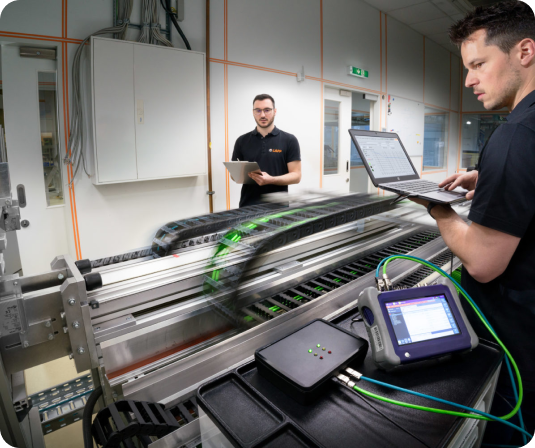Edge Information
System
Empowering Industrial Efficiency: Edge Information System revolutionizes data processing and decision-making at the network’s edge.
Recipe Creation and Management
Recipe Creation and Management drives manufacturing precision by enabling engineers to meticulously define parameters, settings, and step-by-step instructions for each production stage. This system optimizes operational efficiency, ensuring consistent quality by tailoring variables such as temperatures, pressures, timings, and quantities to meet dynamic manufacturing demands.


Recipe Distribution
Central to manufacturing efficiency, this system swiftly disseminates meticulously defined production instructions to edge servers. It enables rapid configuration of automation controllers, PLCs, HMIs, and critical devices across the factory floor, fostering synchronized and optimized manufacturing processes. By facilitating seamless deployment, it ensures consistency and reliability in operational execution, contributing to enhanced productivity and streamlined workflows.
Version Control
Version Control adapts the systematic management of recipe evolution, implementing robust measures to track changes and updates. This crucial system stands as a sentinel, preventing unauthorized alterations and ensuring the integrity of production blueprints. When troubleshooting, it aids in swift resolution and maintaining operational continuity. This system protects manufacturing processes, ensuring reliability, security, and streamlined adaptation to evolving operational demands.


Data Collection and
Aggregation
Data Collection and Aggregation collects information from an array of sensors, machines, and equipment across the factory floor. By preprocessing this data at the edge, it refines the information before transmission, optimizing network bandwidth and enhancing relevance. Curating this mixed dataset lays the foundation for real-time decision-making, enabling crucial insights that bolster operational efficiency, predictive analysis, and responsive actions.
Data Processing
Data Processing harnesses advanced analytics, normalization techniques, and enrichment processes to distill raw data into actionable insights. Executing these operations at the edge enables swift extraction of critical information, fostering real-time decision-making and responsiveness within industrial frameworks. This streamlined processing reduces reliance on centralized systems and enhances efficiency by extracting valuable insights promptly, driving proactive actions and informed decision pathways.


Real-Time
Decision-Making
Real-Time Decision-Making swiftly interprets live data and triggers immediate actions. This indispensable system processes incoming information, enabling rapid assessments and decisive actions based on the evolving operational landscape. Instant data analysis empowers systems to preempt potential issues, trigger alerts, or execute automated responses. This agile decision-making minimizes downtime and ensures operational continuity. It fosters an adaptive industrial environment where critical actions are enacted promptly, optimizing efficiency and mitigating risks.
Predictive
Maintenance
Predictive Maintenance employs machine learning algorithms to forecast equipment health. Historical data analysis and real-time sensor readings help potential machinery breakdowns or malfunctions before they occur. This proactive approach allows for timely interventions, scheduling maintenance activities precisely when needed, thus minimizing unplanned downtime. By leveraging predictive analytics, this system optimizes equipment lifespan and enhances operational efficiency, reducing disruptions and ensuring continuous productivity.


Security
Security in industrial contexts embodies a robust system that protects sensitive data within factory premises. It employs comprehensive measures to mitigate the risks of data breaches, ensuring the confidentiality of critical information. It shields data before transmission, bolstering defenses against unauthorized access with encryption protocols. Keeping sensitive data within the factory domain prevents external threats, fostering a secure operational environment essential for maintaining trust, compliance, and resilience in industrial infrastructures.
Bandwidth
Optimization
Bandwidth Optimization employs intelligent algorithms to discern essential data from the influx of information, reducing redundant or less critical data sent over the network. It minimizes bandwidth usage, alleviates network congestion, and curtails data transmission costs by selectively transmitting only pertinent information. This optimization ensures swift and reliable data delivery, facilitating seamless operations across industrial environments and maximizing overall operational efficacy.


Local Control
Local Control enables immediate and precise operations management that helps with latency concerns or unreliable internet connectivity. By decentralizing control, it ensures uninterrupted functionality and responsiveness. This localized authority enhances operational reliability and fosters adaptability, providing a resilient framework capable of swiftly responding to dynamic operational challenges within industrial settings.
KPI
By tracking KPIs, industries can measure productivity, identify areas for improvement, and make informed strategic decisions. KPIs act as navigational beacons, guiding operational strategies, optimizing resources, and fostering continuous improvement initiatives to drive success within industrial environments. These quantifiable parameters are tailored to reflect specific operational objectives, allowing for performance evaluation against set benchmarks.

Overall, Edge Information System enhances the efficiency, reliability, and responsiveness of industrial processes by bringing data processing and decision-making closer to the data source.

